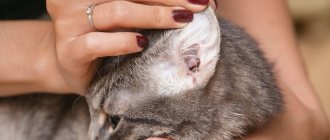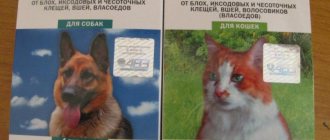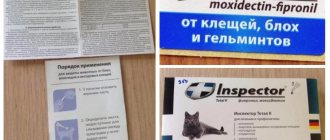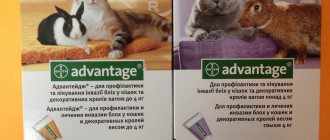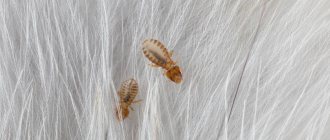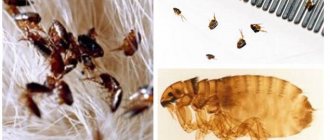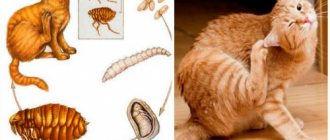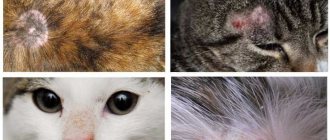What is an ear mite
Ear mites are microscopic ectoparasites. Adult individuals have a body length of 0.3-0.6 mm, so it is impossible to examine them without a microscope. They live in your pet's ear. At first, mites infect its outer part (outer ear), but gradually penetrate deeper and deeper.
The parasite has a claw-shaped mouthparts with which it pierces the skin. The parasite feeds on lymph and tissue fluid protruding to the surface.
Otodectosis can be recognized by the following signs:
- a cloying and unpleasant odor appears from one or both ears;
- a brown and loose coating appears inside the ear, under which ulcers and wounds form;
- the cat tilts its head towards the sore ear and scratches it;
- If an animal is severely infested with ticks, its hearing may deteriorate.
Without treatment, the disease progresses. The tick penetrates deeper into the animal's ear, infects its inner part, and then inflammation of the meninges occurs. In this case, the pet’s temperature rises, and seizures similar to epileptic seizures may begin.
Review of popular drugs for ear mites
Drops intended to kill ear parasites are divided into two types: some are instilled into the ears of cats, and others are applied to the pet’s withers.
The first drugs include:
- Bars (dimpylate and diazinon). This drug is bottled in glass bottles of 10 and 5 ml, or plastic bottles (30, 20, 15, 10 and 5 ml). For cats, the medicine is instilled into both ears, 2-3 drops. The course of treatment is two treatments with a break of 7 days.
- Surolan (prednisolone, polymyxin and miconazole). The drug has the form of a thick transparent suspension. Available in plastic bottles of 15 or 30 ml. Surolan effectively fights not only ear parasites, but also other diseases caused by fungi and bacteria (otitis media, dermatitis, etc.). The suspension is instilled into each ear, 3-4 drops, for 2 weeks.
- Oricin (ivermectin). The drug goes on sale in plastic bottles containing 25 ml of solution. Each bottle has a convenient dropper spout. For mild infection, treatment lasts 3-4 days. If the damage is severe, the course is extended to 7 days. 2 drops are dripped into each ear of the pet.
- Amitrazine (amitraz). An oily, yellow medicine with a pungent odor. It goes on sale in white plastic bottles of 20, 15 and 10 ml. 2-3 drops of medicine are instilled into the cat's ears. The course of treatment is 3-6 treatments with an interval of 3 days.
- Otoferonol. Available in three varieties: Plus (cycloferon and deltamethrin), Gold (cycloferon, deltamethrin and propolis extract) and Premium (permethrin). Dosage for cats: 2-3 drops in each ear. The course of treatment consists of two treatments, the interval between them is 7 days.
- Aurican (tetracaine, diazinon, prednisolone and hexamidine). Drops are poured into 20 ml bottles. The treatment regimen is as follows: the first 7 days - daily treatment with 4-5 drops in each ear, then treatment is carried out twice a week for 30 days.
Names and descriptions of drugs that are applied to the withers:
- Stronghold (selamectin). The medicine is packaged in small sealed pipettes. For cats, the dosage of selamectin is 45 mg (0.75 ml pipettes). Stronghold is applied to the pet’s withers once.
- Advocate (imidacloprid and moxidectin). The drops are sold in sealed pipettes. For cats, two dosages are available: for pets from 1.5 to 4 kg, and for large animals from 4 to 8 kg.
REFERENCE! You can fight ear mites not only with drops. Pet stores offer ointments, injection solutions and sprays that help rid your pet of parasites.
How to use various remedies for ear mites in cats
Before using medicinal drops, it is recommended to first clean the inflamed ear from scabs, then drip 3-5 drops of the medicine into each ear. If necessary, therapy should be repeated after 5-7 days.
Attention! Even if only one ear is inflamed, the drug is still injected into both.
In case of severe damage, the method of application is to treat every other day until the unpleasant signs of infection disappear.
Rules for the use of drugs
Treating a cat for ear parasites requires preliminary preparation. Before the procedure, it is necessary to heat the medicine to a temperature of 25-27 degrees. You should also prepare equipment: cotton pads, bandages or gauze, a solution for cleaning the inside of the ear.
The procedure is carried out as follows:
- The cat is calmed and restrained well. To do this, you can use a durable bag, carrier or thick blanket.
- The cat's ears need to be cleaned of brown deposits. To do this, a special lotion or saline solution is instilled into each ear, the auricle is folded in half and gently massaged. After this, the soaked plaque is removed with a clean cotton pad.
- The amount of the drug indicated in the instructions is instilled into each ear of the cat.
- After applying the drops, the base of the ear is folded and gently massaged so that the medicine is evenly distributed over the surface.
- After treatment, the animal is released. After this, the cat actively shakes its head, and excess drug is removed from the ear.
IMPORTANT! Many cats behave very aggressively during ear treatment, so it is necessary to securely restrain the pet.
Features of application
Before using the drops, it is necessary to clean the ear canal of pus, scabs and crusts. To do this, you can use cotton swabs soaked in a warm solution. After cleaning the passage, you can proceed directly to instilling the solution.
Something else interesting: Cat Bayun for cats - instructions for use
The drug is instilled into the external auditory canal 2-3 times a day (more often on the first day of treatment). The ears are then gently massaged for better penetration. Excess should be wiped off with a cotton swab. The duration of the course of treatment is 3–7 days, depending on the condition of the pet.
Ear drops can have either a single or combined effect. All agents are divided depending on what infectious agents they act on and what effect they have. Let's take a closer look at the most common means.
Leopard
It is a drug of combined action. The main substance is dimpylate. It is active against ticks and insects, including fighting the causative agent of otodectosis. Additional components that are part of the solution have an anti-inflammatory effect and also reduce tissue swelling.
The main indication for use of the drug "Bars" is ear scabies (otodectosis).
Otoferonol
A drug with pronounced anti-inflammatory activity. The main active ingredient is cycloferon. Reduces signs of inflammation, relieves swelling and relieves pain in cats.
There are several types of the drug:
- "Otoferonol Gold" also affects ticks. This is explained by the fact that the drug contains another basic component – deltamethrin. It blocks the transmission of nerve impulses from nerve tissue to muscles, thus leading to paralysis and death of the insect.
- Otoferonol Premium, thanks to its additional composition (in the form of permethrin), also affects ticks, leading to their death. In addition, the drug contains dexamethasone, a glucocorticoid that provides a stronger reduction in swelling.
Otidez
"Otidez" is a combination drug and has a wide range of applications. This is due to the following composition:
- gentamicin is an antibiotic that has a bactericidal effect;
- permethrin – fights ticks, leading to their death;
- dexamethasone is a glucocorticoid that reduces inflammation and swelling;
- terbinafine hydrochloride is an antimycotic substance aimed at destroying pathogenic fungi;
- Jubenzocaine is a local anesthetic that helps relieve pain.
Otibiovin
"Otibiovin" is a drug that has an antimicrobial effect and also reduces inflammation and pain. Its complex action is due to the following composition:
- gentamicin – destroys pathogenic microorganisms, used to treat bacterial otitis;
- triamcinolone glucocorticoid - a corticosteroid with a pronounced anti-inflammatory effect, reduces itching;
- salicylic acid is an antiseptic and soothing component.
Something else interesting: Rules for choosing and using eye drops for cats
The main indication for use is bacterial otitis media, which is accompanied by swelling, pain and inflammation.
Anandin
Anadin is used to treat bacterial otitis. The basic active ingredient is gramicidin C, which is a local antibiotic. Has a bactericidal effect on gram-positive and gram-negative microorganisms. Additional components that are included in the drops help reduce the inflammatory reaction and also accelerate regeneration processes.
After using Anadin drops, the cat’s inflammation and pain decrease, the drug acts directly on the cause of otitis media.
Surolan
"Surolan" is a complex remedy that is used to treat otitis media of a bacterial or parasitic nature, as well as for otodectosis. The effects that Surolan has are due to the substances that are included in its composition:
- miconazole is a substance that is aimed at destroying pathogenic fungi;
- polymyxin B is an antibiotic that affects gram-negative microorganisms;
- prednisolone is a glucocorticoid that reduces the manifestation of the inflammatory reaction, swelling, pain and itching.
Tsipam
"Tsipam" is a combination drug whose main effect is aimed at ticks. It contains 2 active ingredients:
- cypermethrin;
- amitraz.
The action of each of them is to block the conduction of nerve impulses, which leads to muscle paralysis and death of the tick. The main indication for the use of Tsipam drops is ear mites.
Contraindications
Like any other medications, ear drops have a number of contraindications:
- Hypersensitivity to the components of the drug (including a history of allergic reactions).
- Suspicion of perforation of the eardrum.
- Pregnancy and lactation (use of the drug during this period is permitted only after consultation with a veterinarian).
After using the drops, you must carefully monitor the cat's condition; if allergic manifestations or other side effects occur, you must seek medical help.
Contraindications, side effects and precautions
Most anti-ear mite medications have an age limit. Small kittens under 2 months of age should not be treated. It is also not recommended to treat weakened animals with drops.
Possible side effects include the development of an allergic reaction. It is rarely observed, and in this case the pet should be taken to a veterinarian.
Before treating your cat with drops, you must put on medical latex gloves. If the medicine gets on the skin, wash it well with soapy water. Drop containers are disposed of with household waste.
